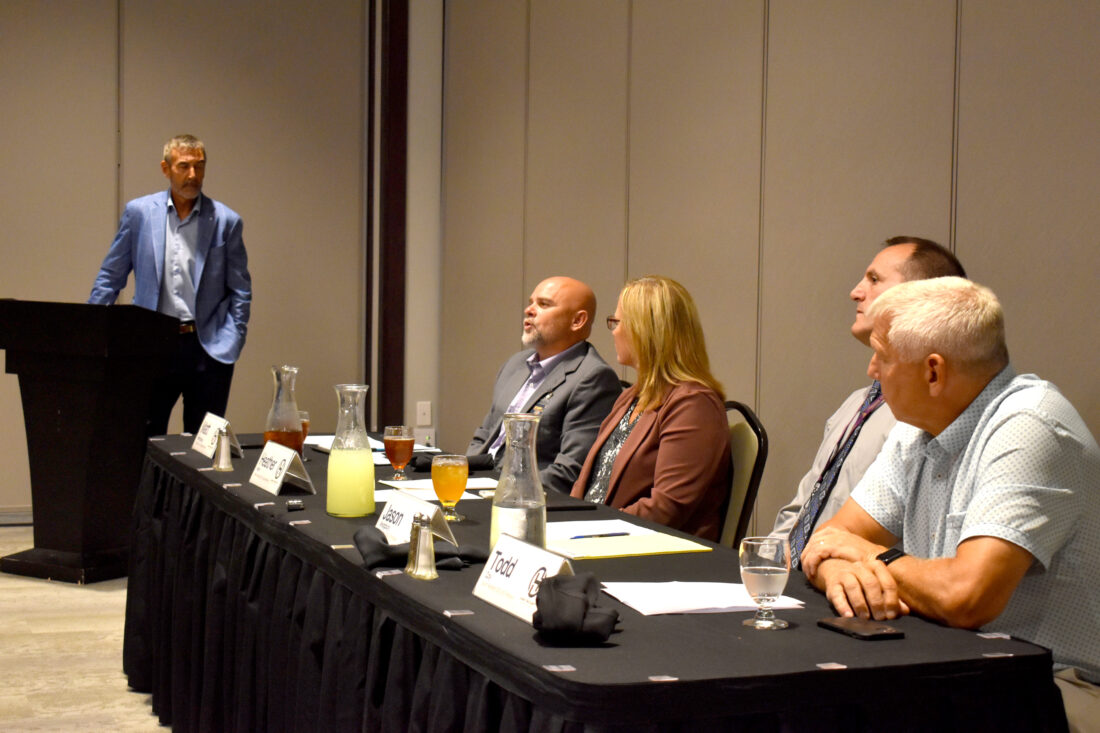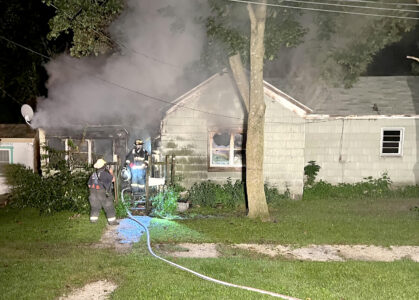Home turf
The Alliance’s Ottie Maxey asks how educators can help students thrive, and stay

Daily Freeman-Journal photo by Jane Curtis: Matt Berninghaus, superintendent of the Webster City Community School District, talks about education and business partnerships that help improve the learning experience for local students during a forum Thursday at Briggs Woods Conference Center. In the background, Ottie Maxey, director of Economic Development for Hamilton County and Webster City at the Ames Regional Economic Alliance, listens. Also pictured are, left from Berninghaus, Heather Holm, South Hamilton’s superintendent; Jason Wedgbury, new Webster City High School principal; and Todd Coy, South Hamilton High School principal.
By JANE CURTIS
Ottie Maxey began last week’s education forum this way: “Today’s conversation is exploring about how we, schools, businesses, and community stakeholders, ensure our students are ready to thrive here at home in Hamilton County.”
It was Maxey’s first such local event in his role as director of Economic Development for Hamilton County and Webster City at the Ames Regional Economic Alliance, a three-county cooperative effort that also includes Story and Boone counties.
Maxey retired as superintendent at Ballard in 2022 after having worked in education for nearly three decades. In Story County, he has hosted a similar forum, he said, the goal of which is to parse out the relationship between education, economic development, and the retention of young people.
To his credit, he had managed to pack a dining room at Briggs Woods Conference Center Thursday at noon, even though an Iowa Tourism Insiders meeting was in town. Seated around the tables were Hamilton County’s leaders: county supervisors, business owners and other business executives. The panel before them comprised Hamilton County’s top education leadership: both Webster City and South Hamilton superintendents and their high school principals.
Maxey asked Matt Berninghaus, Webster City’s superintendent, the first question: What steps is the district taking to prepare students for local careers? He put the emphasis on agriculture, manufacturing, healthcare and skilled trades.
“Within the ag education program, we currently offer 29 courses to our students throughout the year. Four of those courses are enterprise courses, so we’ve got kids that are running businesses out of our ag department, where a few of them; well, woodworking is one of them, metal processing is one, small engine repair is one, and out of our greenhouse as well. So they’re actually running businesses out of there, seeking things to work on from community members, and then just organizing from there.”
Previously Berninghaus had detailed collaborations with other institutions that help create the existing network of local education.
“We’ve got the Career Ag Academy that we’re just starting to use this year,” he said. “If you haven’t heard about that one yet, it’s a state-of-the-art facility. It’s animal science, meat science is the focus. It’s paid for by private donations. It’s an over $2 million facility that’s out at the Hamilton County Fairgrounds. So it was between a partnership between the Career Ag Academy Board, the Hamilton County Fair Board and the Webster City School Board.”
He added, “(We) have Iowa Central Community College, the partnership with our local community college. It’s outstanding. We offer dual credit programs to kiddos, both in our community, at our local campus. Students can attend the Triton Academy, which is kind of focused on career and tech ed at Fort Dodge. And then, in Eagle Grove, we have the North Central Career Academy.” The focus there is on career and tech education, he said.
Heather Holm, South Hamilton’s superintendent, echoed Berninghaus. “I think we do a lot of the same things, maybe just on a smaller scale than Webster City.” However, South Hamilton, due to its location nearer Ames and Des Moines, tends to partner with the Des Moines Area Community College, she said.
In Webster City, it is agriculture that stands out for increased attention to staffing and programming, according to Berninghaus.
“Two years ago we had 1.2 ag teachers and we’re up to four ag teachers right now,” he said. “We’ve got over 200 students that are in FFA. We’ve increased our ag offerings. So, I said we had 29 courses. We’ve increased those offerings by 18 new classes.”
Webster City High School also offers six business courses, he said.
The superintendent also talked about a new internship initiative being created in partnership with local businesses.
“Something else that we’re also doing is work-based learning, so we’re really ramping up that program so we can do job shadows, internship courses, and just experiences for our kiddos to get out in the community and work with the businesses that we’ve got within our communities.”
To that end, he said ag teacher Kurt Veldhuizen is working with area businesses to identify needs.
“Students are gonna be going out, working the businesses, getting credit for their time spent with those businesses. And happy to say we have over 20 agreements with business and partnerships that are in place right now, and we’re always looking to expand upon that.”
When the conversation lurched into a discussion of cell phone use in the schools and the recent change in what is allowed, Todd Coy, South Hamilton High School principal, shared his experience.
“There were many times that we’ll be sitting in the office, and this parent will walk into the office and say, I’m here to pick up my son or daughter. For what? They don’t feel well. They haven’t been down to the office, they text them from their classroom, and then we call them down. So that has stopped.”
Berninghaus explained that he was about to get on his soapbox.
“There’s great research out there now on cell phones, social media, and what that’s doing to our kids. If you’ve not read the book ‘The Anxious Generation,’ or not heard of it, I highly suggest you pick it up and read it. Especially if you have kids or grandkids. But what we’re doing and how we are rewiring the brain for our kiddos by getting them access to these devices at a young age and how they grow up with play-based youth versus phone-based youth, you know. We might be able to see some of our kids or our grandkids, you know, that they’re on their devices all the time. And what that does to our kids long term with the increased anxiety, the lack of some social skills that we’re seeing with our school systems as well. Sleep loss, addiction, we’re seeing more of that stuff. And we’re 15 years from the onset of social media, right? It happened in, I think it was the 2010s. And so there’s data now that kind of shows and supports what we’re doing to our kiddos. So yeah, to your point, there’s research out there. I think we need to look at that a little bit more and try to help our kiddos future and where this is going to go.”
Todd Van Epps, general manager of Stratford Communications, a fiber optics service provider seated at a table near Berninghaus, offered a different perspective.
“I want to … throw something out a bit differently and we’ll strap for communications. So we are internet and we’re, you know, we supply the pipe. But the other side of it, I think there’s careers out there that we don’t even know what they’re going to be yet. And they’re all going to be around AI and computer and tablets and whatever it might be. So I think there’s good benefits to it. I don’t think you can just sit there and be a consumer. That’s, I think, where we get that brain drain. But there’s going to be things, coding and things like that that are out there that we should be working with these kids somewhere along the way because, again, they’re going to be the generation that invents who knows what the next thing will be. I think controlling it, to your point, Matt, is solid, but let’s use this up to our advantage, too, to see what the next thing is going to be.”


